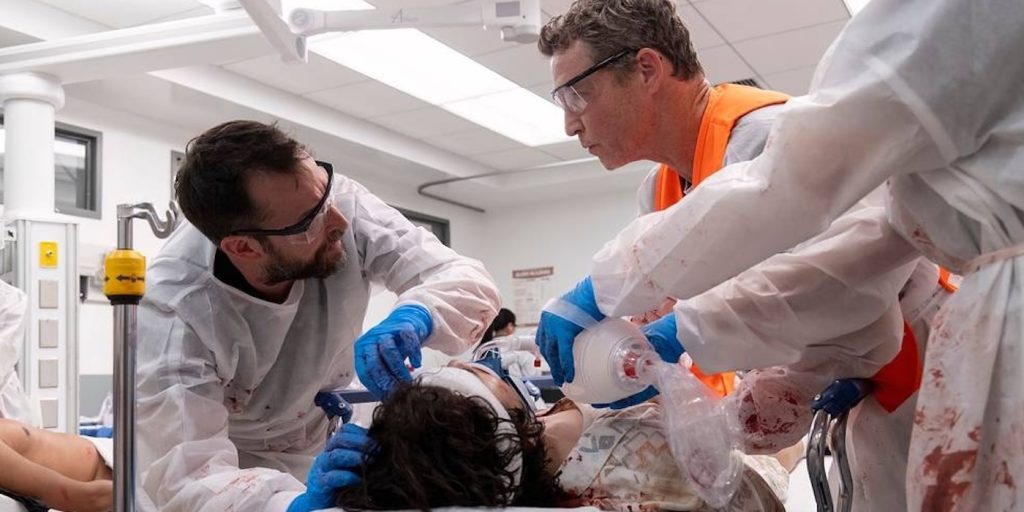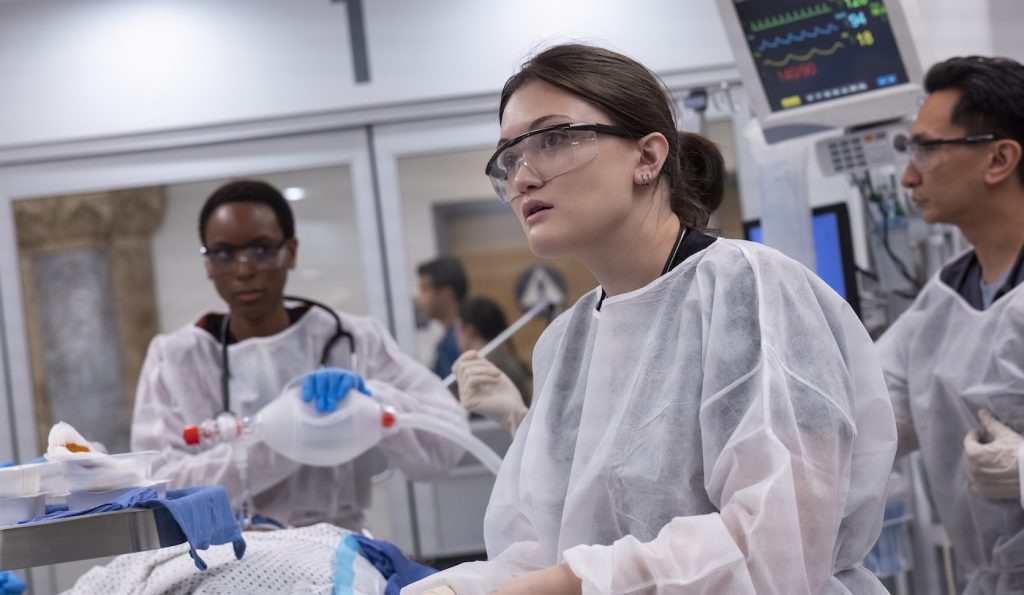Precision and Passion: How Director Amanda Marsalis Choreographed the Chaos of “The Pitt”
There are few careers that could fill an entire season of TV with a single day’s work, but The Pitt proves that the emergency room is a source of endless inspiration. Drama and trauma pump into a Pittsburgh hospital led by attending Dr. Robby (Noah Wyle) over fifteen hours.
Medical dramas aren’t new to the screen – in fact, Wyle is well known for his role as Dr. John Carter on ER. Yet, from the jump, The Pitt refreshes the genre with its real-time approach and compassionate portrayal of the most pressing contemporary health crises. Director Amanda Marsalis (Ozark, Ransom Canyon) wasn’t sure if she was right for the project, but the script quickly won her over.
“I was like, ‘Medical drama? That’s not really my thing.’ I like prestige television. I like Ozark. I like a long dolly shot,” she reasoned. “But I really, really love and respect [executive producer] John Wells. When I read episode 1, I was like, this is awesome, and then when I talked to John and [creator R.] Scott [Gemmill] about how they wanted to make the show, I was just like, ‘Great. I’m on board.”
Each episode depicts one hour in the medical staff’s shift starting at 7:00 A.M. Marsalis helmed four of the season’s most gripping episodes. She and her team choreographed multiple patients and moving parts, establishing the way the E.R. operates.
“Our wonderful production designer, Nina [Ruscio], had built a model of the set. I blocked everything out,” Marsalis explained. “We had the model so that I would place all the beds, and then I would put the scene number on the set, and we would photograph it. We made a book, basically, and passed it out to the ADs so everyone knew where everything should be in every scene. I need to make sure that technically everything is in its place so that we see it and we understand the devastation and heartbreak and pain or horror of something like this.”
Marsalis thrives in planning. She comes in early, ready for the long, fast-paced days.
“I really, really enjoy the mathematical side of directing, which is all of the prep,” she said. “I really think that episodes are made in prep, so that when you get there on a day, most people have the information that they need, and you can all move forward together, making something that you want to make and telling the story that you want to tell.”

Although coordinating The Pitt scenes was extremely complex, Marsalis ultimately prioritizes the human interaction. As a photographer for two decades, she finds beauty in everything, even a windowless emergency room. Although The Pitt is unlike any project she’s directed before, she always sets the same standards for her own work.
“My consistency is quality. Ozark and The Pitt are nothing like each other, but I do think if you watch my episodes, you can tell they’re mine,” she noted. “I really believe in intimacy and that kind of storytelling that you feel very connected.”

The Pitt takes place in a teaching hospital where interns and residents are eager for their shot at the most interesting cases. Marsalis’ episodes highlight a wide range of emergencies, such as accidental fentanyl overdose, drowning, and sickle cell crisis. The team did as much research as possible, and consultants were on set to ensure the accuracy of the medical procedures.
“We have Dr. Joe Sachs, who is like our main doctor. He was also on ER,” Marsalis shared. “We had three other doctors with us who helped prep each episode and gave all our medical notes. Plus, we had nurses on set, so our nurses would be like, ‘That’s not how you would do that.’ They have the right to be like, ‘That’s not right. We need to fix it.’”
The doctors engage in occasional flirtation with one another, but they are focused on the medicine. There are no steamy scenes, however, that doesn’t mean that the streamer is without cable-level nudity. Marsalis felt that the realistic, clinical depiction of the human body helped to give weight to the plot.
“One of my favorite things is that we have some nudity in the show,” she noted. “Nonsexual, realistic nudity of what happens to your body whenever you come into the E.R. These people just need to cut your clothes off, or they just need to do whatever, and that just doesn’t matter. It’s medically necessary nudity, and that is just how we show that it’s real. I think it really just helps our understanding of how vulnerable people are when you come there and how much you’re in the hands of these doctors.”

Any realistic depiction of a hospital will also involve a lot of bodily fluids, as the kind country boy Dr. Whitaker (Gerran Howell) discovers. He has the unfortunate luck of seeing multiple patients who soil his scrubs, but every doctor gets messy at some point. One of the most utilized effects was fake blood, and Marsalis said there was no shortage in volume or variety.
“There’s floor blood, there’s mouth blood, there’s dark blood, there’s arterial blood, there’s clothing blood. The amount of different departments involved in blood is just wildly entertaining,” Marsalis laughed. “There was a lot of resetting. You’re like, okay, that was great. Let’s do it again. Let’s start over.”

An emergency suddenly changes everything during episode 12, “6:00 P.M.,” directed by Marsalis. It’s one of the most stunning hours of TV of the year, giving a terrifying glimpse into the dangerous and difficult conditions surrounding first responders.
The show empathetically portrays the extreme conditions doctors face every day to save lives. Dr. Robby and his team battle normal physical limitations like hunger, exhaustion, and even needing to use the bathroom. They also endure the mental strain of know-it-all parents referring to Google, the grief of losing a patient, or the pressure of mass events like COVID or a deadly shooting. Marsalis has been heartened by the response the show has received from real-life medical professionals.
“We got a really wonderful message from a doctor who was at the shooting in Vegas,” she relayed. “She basically was like, ‘Hey, the PTSD – you did this so, so well.’ The amount of people reaching out – it’s really moving because it’s like a whole population of people who feel seen. Man, I’m grateful for that.”
Marsalis’ episodes explore the emotional and psychological toll on caretakers as they navigate difficult decisions like end-of-life, DNR orders, and organ donation. The Pitt cast and crew faced their own emergency when wildfires in L.A. shut down production for a few days. Marsalis had also recently lost her own father before filming a scene in which adult children come to terms with their parents’ final hours. She recalled wiping away tears between takes of the moving moment. That human connection in a setting that can seem clinical is where the magic happens.
“The Pitt is entertaining and it’s really good storytelling,” Marsalis reflected. “I think the thing that’s really, really lovely about The Pitt is that it’s a show about a bunch of good people who are trying to do right. I love watching The Pitt. I love watching everyone’s episodes. It’s really great and I love Scott, John, and Noah. I think that’s just something that’s really fun about it. It’s just a bunch of people that care, and I think in this day and age it feels really nice to see people that care.”
The Pitt season one is streaming now on MAX.
For more on The Pitt, check out these stories:
Featured image: Robby and team work to pinpoint Nick’s condition. (Warrick Page/MAX)



